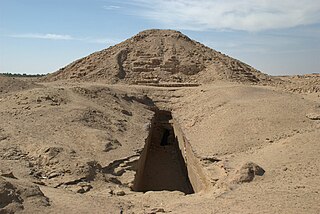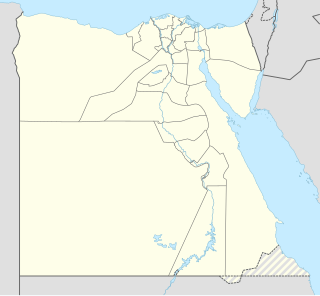 W
WThe Twenty-fifth Dynasty of Egypt, also known as the Nubian Dynasty or the Kushite Empire, was the last dynasty of the Third Intermediate Period of Egypt that occurred after the Nubian invasion.
 W
WEl-Kurru was one of the royal cemeteries used by the Nubian royal family of Kush and Egypt's 25th Dynasty. It is now located in Northern state, Sudan. Excavated by George Reisner, most of the royal Nubian pyramids date to the early part of the Kushite period, from Alara of Nubia to King Nastasen.
 W
WKawa is a site in Sudan, located between the Third and Fourth Cataracts of the Nile on the east bank of the river, across from Dongola. In ancient times it was the site of several temples to the Egyptian god Amun, built by the Egyptian rulers Amenhotep III and Tutankhamun, and by Taharqa and other Kushite kings.
 W
WTomb KV33 is a non-royal tomb located in the Valley of the Kings in Egypt. It was discovered by Victor Loret in 1898 and was not fully cleared at the time of its discovery. The tomb site was eventually resealed for later detailed excavation.
 W
WNuri is a place in modern Sudan on the west side of the Nile, near the Fourth Cataract. Nuri is situated about 15 km north of Sanam, and 10 km from Jebel Barkal.
 W
WThe Shabaka Stone, sometimes Shabaqo, is a relic incised with an ancient Egyptian religious text, which dates from the Twenty-fifth Dynasty of Egypt. In later years, the stone was likely used as a millstone, which damaged the hieroglyphs. This damage is accompanied by other intentional defacements, leaving the hieroglyphic inscription in poor condition.
 W
WThe Sphinx of Taharqo is a granite gneiss statue of a sphinx with the face of Taharqo. He was a Nubian king, who was one of the 25th Egyptian Dynasty rulers of the Kingdom of Kush. It is now in the British Museum in London.
 W
WAt least three ancient Egyptian granitic gneiss statues of Amun in the form of a ram protecting King Taharqa were displayed at the Temple of Amun at Kawa in Nubia. Construction of the stone temple was started in 683 BC by the pharaoh Taharqa. The ram is one of the animals sacred to Amun and several temples dedicated to Amun, including the one at Karnak, featured ram or ram-headed sphinx statues.
 W
WThe Temple of Mut, also named Temple B300, is a temple at Jebel Barkal in Northern State, Sudan. It is situated about 400 km north of Khartoum near Karima and stands near a large bend of the Nile River, in the region that was called Nubia in ancient times. The partially rock-cut temple was built on the west side base of the Jebel Barkal pinnacle, from which angle it assumed the shape of an Uraeus wearing the White Crown of Upper Egypt. Dedicated to the goddess Mut, the wife of Amun, the Temple of Mut was erected by pharaoh Taharqa in the 680s BCE, at a time when he ruled Upper and Lower Egypt.
 W
WThe Victory stele of Esarhaddon is a dolerite stele commemorating the return of Esarhaddon after his army's 2nd battle and victory over Pharaoh Taharqa in northern ancient Egypt in 671 BC. It was discovered in 1888 in Zincirli Höyük by Felix von Luschan and Robert Koldewey. It is now in the Pergamon Museum in Berlin.